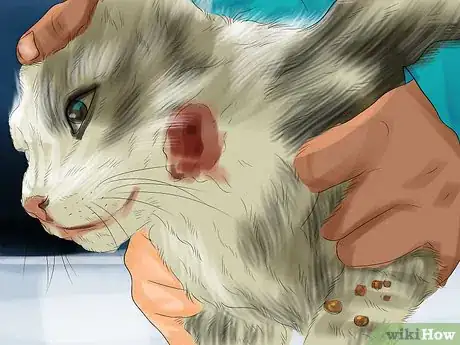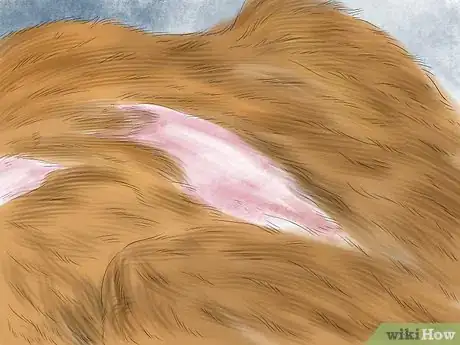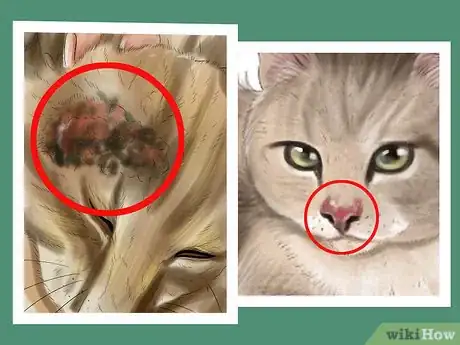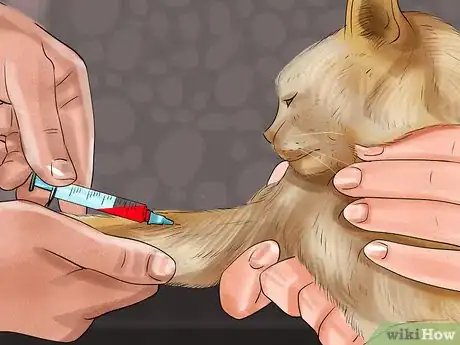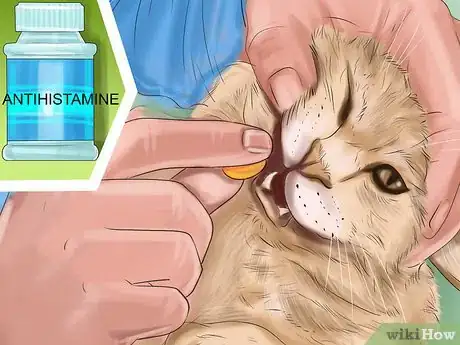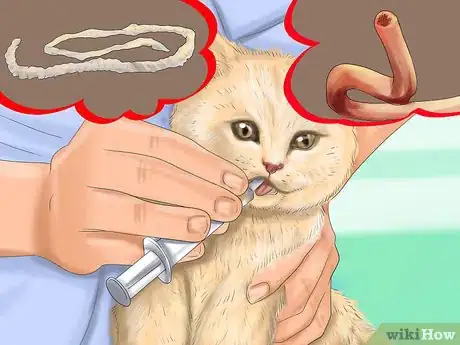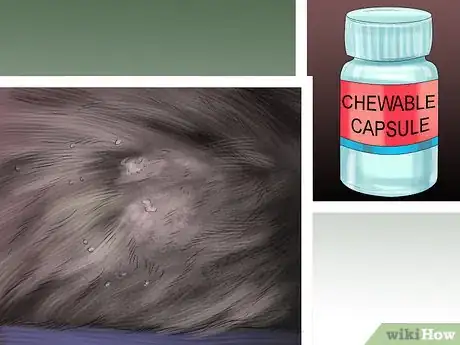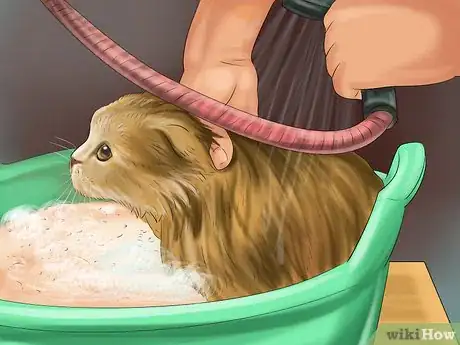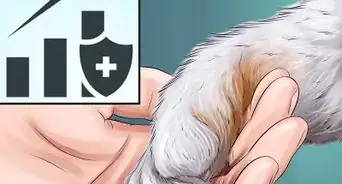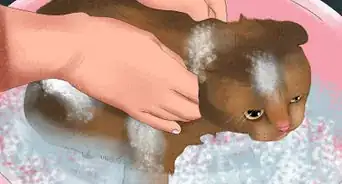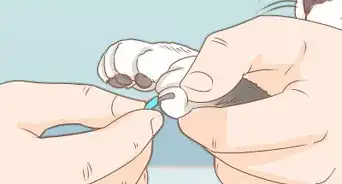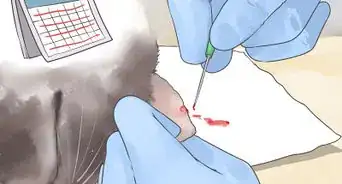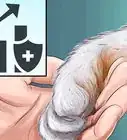This article was co-authored by Lauren Baker, DVM, PhD. Dr. Lauren Baker is a Veterinarian and Assistant Scientist at the University of Wisconsin-Madison. With over 10 years in veterinary medicine, she specializes in the concept of “one health,” which uses insights from veterinary medicine to help human medical research. She holds a Ph.D. in Comparative Biomedical Sciences, a Doctor of Veterinary Medicine, an MS in Comparative Biomedical Sciences, and a Bachelor’s degree in Psychology from the University of Wisconsin-Madison.
There are 16 references cited in this article, which can be found at the bottom of the page.
This article has been viewed 18,078 times.
Diagnosing feline skin problems is accomplished through a combination of evaluating visual or behavioral clues and conducting diagnostic tests. For instance, if your cat’s skin exhibits redness, crusting, or sores, or if your cat is biting or itching, it likely has skin problems. Your next step should be to take your cat to the vet, who can run blood tests and take fungal cultures to diagnose your cat.
Steps
Looking for Symptoms
-
1Look for wounds. Wounds might be painful, moist, oozing, or discharging. Alternately, they might already by scarred over, and you might find only spots or scabs left behind by a nasty feline skin problem.[1]
- When you detect a wound on your cat, monitor it regularly. If it changes color or begins to ooze, stink, or discharge, the wound is infected. Contact your vet for further instructions.
-
2Look for crusting skin or dandruff. Dry, flaky, or crusting skin is a common problem in felines. The condition could be due to any one of a variety of medical conditions. For instance, your cat might have mange, a condition caused by parasitic mite infestations.[2] Diabetes is also a possible cause. Abnormal skin growths (neoplasia) or cancers are also a potential culprit.[3]Advertisement
-
3Watch your cat’s behavior. Irritation is best detected by watching your cat’s behavior. If your cat shakes its head, bites, or excessively licks a particular part of its body, it’s probably due to skin irritation.[4]
-
4Check for bald spots. If your cat has an area of irritation – a wound, abscess, or other skin problem – they will probably reveal the irritated area by licking it excessively, leading to hair loss. In the course of normal interactions with your cat, check it regularly for wounds and areas of hair loss.[7]
- Before the area is completely denuded of fur, you might be able to see matted areas on your cat’s fur. This is also a sign that your cat has a skin problem.
-
5Look for color changes. Macules – areas of the skin that change color – are common in feline cases of inflammation or injury. Redness is the most common macule discoloration. If your cat’s fur is thin and you can see its skin, check for red skin. Other color changes are also possible, though, including brown, red, black, yellow, and reddish purple.[8]
- Yellow, or jaundiced, skin often results from liver disease.
- Redness, the most common type of discoloration, is produced by a vast number of conditions, including malassezia (a yeast infection) or cancer.
- Wheals – raised areas of the skin, sometimes referred to as “cat hives” – might appear whitish or red.
-
6Look for sores or lesions. Sores and lesions are feline skin problems associated with raised, discolored bumps on the skin. They might be filled with pus or fluid. Like other feline skin problems, sores and lesions can originate due to a diverse array of different conditions. For instance, your cat might have:[9]
- A bacterial infection
- Flea or mosquito bite hypersensitivity, a kind of allergy
- Burns, which can produce lesions if the cat is burned badly
Getting a Diagnosis
-
1Take your cat to the vet. If you notice any indication of skin problems, take your cat to the vet for a proper diagnosis. Your vet will be able determine the cause of your cat’s skin problems and provide a remedy.[10]
- Your vet will first initiate a visual examination to check for fleas and examine the area of irritation.
- If they don’t immediately find something, they will take a biopsy (a skin scraping) to check for mites and infections.
- Your vet might also use a fungal culture to check for ringworm. This involves testing your cat’s fur and skin for presence of the fungus that the vet suspects caused your cat’s skin problems.
-
2Get a blood test. If the visual examination, biopsy, and fungal culture fail to identify anything out of the ordinary, your vet might take a blood sample from your cat. The process is not unlike that which you experience when getting blood drawn at the doctor’s office. Your vet will simply use a needle to puncture the skin and draw blood from your cat.[11]
- Your vet might ask you or an assistant to reassure or restrain the cat when drawing its blood.
- Blood tests might reveal allergies that could be the underlying cause of your cat’s skin problems.
-
3Share information about your cat’s lifestyle. When you bring your cat to a vet for diagnosis, let them know of any recent significant changes to your cat’s lifestyle. For instance, if you recently changed your cat’s cat food or moved to a new home, share that information with your vet.[12]
- Let your vet know if other cats or house pets are suffering from a similar skin condition. Whatever your cat has might be contagious.[13]
- The more information about your cat you share with your vet, the better they will be able to diagnose the situation.
-
4Follow the vet’s treatment recommendations. Your vet will recommend an appropriate solution based on their analysis of your cat’s skin problem. For instance, you might need to apply anti-inflammatory medications or antihistamines (medications that control the immune system). Antibiotics or antifungal treatments might be necessary in the case of an infection. Non-medical solutions could include creams, ear drops, or a simple haircut for your feline friend.[14]
- Always use medications as directed.
- Contact your vet if you have questions regarding treatment.
Keeping Feline Skin Healthy
-
1Keep your cat out of sunlight for extended periods. Just like people, cats can get too much sun. Cats that spend too much time in the sun can get dry skin and sun damage. The exact amount of time your cat needs in the sun depends on its breed. Talk to your vet about your cat’s sunshine needs.[15]
- Cats with white ears, noses, and eyelids are more likely to get sun-damaged skin than cats with darker skin.
-
2Maintain flea control in your home. If your home gets infested by fleas, it can be hard to get rid of them. Talk to your vet about the best options for flea control in your home. Your vet will provide advice based on their knowledge of your cat’s health and breed.[16]
- The most common flea prevention methods are oral medications and spot-on products that keep fleas away from your cat.
- You can also limit the odds that your cat will contract fleas by keeping it away from stray cats and limiting its outdoors time.
-
3Give your cat a balanced diet. A balanced diet promotes healthy skin.[17] A healthy feline diet contains fatty acids, vitamins, amino acids, and minerals. Look for a cat food that is labeled with an Association of American Feed Control Officials (AAFCO) statement attesting to its nutritional completeness.[18]
- The best-quality cat foods will have meat, meat byproducts, or seafood listed among the first few ingredients.
- Choose a cat food your cat enjoys eating. If your cat turns up its nose at a given cat food, even if it is nutritionally balanced, there are many other nutritionally balanced cat foods available that are more palatable to your kitty. For instance, canned food tends to be preferred over semi-moist food, which in turn tends to be more popular than dry cat food.
- Most cats need to be fed three times daily. Your vet will let you know if your cat needs its diet adjusted based on its age and weight.
-
4Worm your cat regularly. Worming refers to the process of removing the intestinal worms that often populate the feline gut. Cats with large worm populations could develop skin problems.[19] Tapeworms, hookworms, and roundworms are some of the most common worms in cats.[20]
- To deworm your cat, consult your vet. Your vet will be knowledgeable about what sorts of feline worms are most common in your geographical area, and will be able to recommend the most effective deworming treatment based on modern veterinary science.
- Your vet will let you know how often you need to deworm your cat during your regularly scheduled veterinary visits.
-
5Treat the underlying condition. If your kitty has skin problems due to an underlying condition like cancer, diabetes, or a mite infestation, treating that condition is the necessary first step in solving the skin problem. Talk to your vet about the best way to solve your cat’s underlying condition.[21]
-
6Provide supplements to your cat. If your cat has a balanced diet but still suffers from dry, flaky skin, consider adding omega 3 fatty acid supplements to their diet. These are available from many pet stores in the form of chewable capsules that you can simply feed your cat along with its meals.[22]
- Ask your vet to recommend a reputable brand and verify that such supplements would be safe and effective for your cat.
- Always use supplements as directed by the manufacturer.
-
7Wash your cat. Cats usually do not need to be bathed since they clean themselves regularly. But if your cat has skin problems – especially dry or flaky skin – a bath could help treat grimy and matted fur that might exacerbate skin irritation. Use a mild, nontoxic, moisturizing shampoo when washing your cat.[23]
- Bathe your cat when it is relaxed. Baths after a play session are ideal.[24]
- Before bathing, trim your cat’s claws and brush its fur to remove any loose hair. Place cotton balls in your cat’s ears before the bath to keep water out.
- Place your cat in the tub and use a handheld hose or detachable showerhead to get your cat wet.
- Massage the shampoo into your cat’s fur according to manufacturer directions. Rinse the cat off with the hose or showerhead, then dry your cat gently with a towel.
References
- ↑ http://www.cats.org.uk/uploads/documents/cat-care-leaflets-2013/VG04_Itchy_cats_and_skin_disorders.pdf
- ↑ https://www.merckvetmanual.com/integumentary-system/mange/mange-in-dogs-and-cats
- ↑ http://www.merckvetmanual.com/integumentary-system/miscellaneous-systemic-dermatoses/overview-of-miscellaneous-systemic-dermatoses
- ↑ http://www.cats.org.uk/uploads/documents/cat-care-leaflets-2013/VG04_Itchy_cats_and_skin_disorders.pdf
- ↑ http://www.cat-health-guide.org/cat-skin-problems.html
- ↑ http://www.peteducation.com/article.cfm?c=1+2141&aid=205
- ↑ http://www.cats.org.uk/uploads/documents/cat-care-leaflets-2013/VG04_Itchy_cats_and_skin_disorders.pdf
- ↑ http://www.peteducation.com/article.cfm?c=1+2141&aid=205
- ↑ http://www.peteducation.com/article.cfm?c=1+2141&aid=202
- ↑ http://www.cat-health-guide.org/cat-skin-problems.html
- ↑ http://www.cats.org.uk/uploads/documents/cat-care-leaflets-2013/VG04_Itchy_cats_and_skin_disorders.pdf
- ↑ http://www.cats.org.uk/uploads/documents/cat-care-leaflets-2013/VG04_Itchy_cats_and_skin_disorders.pdf
- ↑ http://www.cat-health-guide.org/cat-skin-problems.html
- ↑ http://www.cats.org.uk/uploads/documents/cat-care-leaflets-2013/VG04_Itchy_cats_and_skin_disorders.pdf
- ↑ http://www.cats.org.uk/uploads/documents/cat-care-leaflets-2013/VG04_Itchy_cats_and_skin_disorders.pdf
- ↑ http://www.cats.org.uk/uploads/documents/cat-care-leaflets-2013/VG04_Itchy_cats_and_skin_disorders.pdf
- ↑ http://www.cats.org.uk/uploads/documents/cat-care-leaflets-2013/VG04_Itchy_cats_and_skin_disorders.pdf
- ↑ https://www.vet.cornell.edu/departments-centers-and-institutes/cornell-feline-health-center/health-information/feline-health-topics/feeding-your-cat
- ↑ http://www.cats.org.uk/uploads/documents/cat-care-leaflets-2013/VG04_Itchy_cats_and_skin_disorders.pdf
- ↑ https://icatcare.org/advice/worming-your-cat
- ↑ http://www.peteducation.com/article.cfm?c=1+2141&aid=205
- ↑ http://www.healthguidance.org/entry/13473/1/Home-Remedy-for-Dry-Skin-in-Cats.html
- ↑ http://www.healthguidance.org/entry/13473/1/Home-Remedy-for-Dry-Skin-in-Cats.html
- ↑ http://www.aspca.org/pet-care/cat-care/cat-grooming-tips
- ↑ http://www.cats.org.uk/uploads/documents/cat-care-leaflets-2013/VG04_Itchy_cats_and_skin_disorders.pdf
About This Article
To diagnose feline skin problems, look for symptoms like wounds, crusting skin or dandruff, bald spots, or lesions. If you see any indications of a skin problem, take your cat to the vet for a proper diagnosis. During the exam, expect your vet to examine the area of irritation and possibly perform a skin scraping or blood test. Once your vet determines the cause of your cat’s skin problems, follow their recommendations, which may include medication, creams, or a haircut. In order to keep your cat’s skin healthy, don’t allow it to spend too much time in the sun, which can cause dry skin. You’ll also want to prevent fleas by using oral preventatives. For more tips from our Veterinary co-author, including how to give your cat a balanced diet to avoid skin issues, keep reading!
